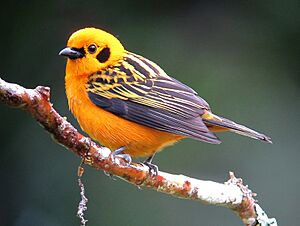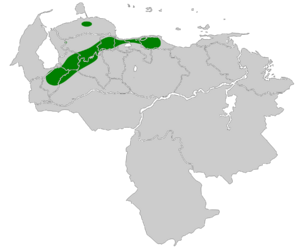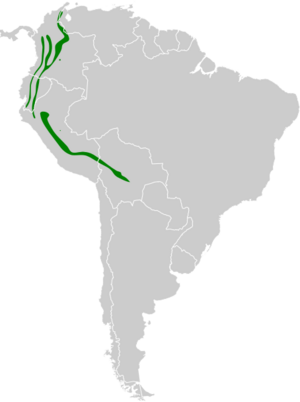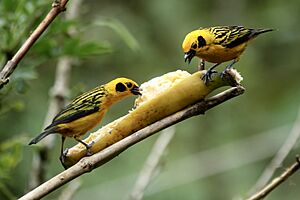Golden tanager facts for kids
Quick facts for kids Golden tanager |
|
|---|---|
 |
|
| At Cali, Valle del Cauca, Colombia | |
| Conservation status | |
| Scientific classification | |
| Genus: |
Tangara
|
| Species: |
arthus
|
 |
|
| Range of the nominate subspecies | |
 |
|
| Range of the other subspecies | |
The golden tanager (Tangara arthus) is a beautiful bird that belongs to the tanager family, called Thraupidae. You can find it in the highland forests of the Andes mountains, from Bolivia all the way north to the Venezuelan Coastal Range in north-western South America. It's a very common bird in these areas.
This bird is mostly golden-yellow. It has black feathers on its back, wings, tail, and around its ears. Some types of golden tanagers, called subspecies, might have more brown feathers on their undersides.
About the Golden Tanager
Scientists give names to living things and group them together. This is called taxonomy. The golden tanager was first described by a scientist named René Lesson in 1840. He found a specimen (a sample bird) in Caracas, Venezuela.
The name Tangara comes from the Tupí language, spoken by native people in South America. It means "dancer." The second part of its scientific name, arthus, honors Arthus Bertrand, who was a French bookseller. The official common name for this bird is "golden tanager," given by the International Ornithologists' Union (IOC). Sometimes, people also call it the "chestnut-breasted tanager."
The golden tanager is one of 27 different species in the Tangara group. It is closely related to several other colorful tanagers, like the blue-whiskered tanager, green-and-gold tanager, emerald tanager, silver-throated tanager, saffron-crowned tanager, golden-eared tanager, and flame-faced tanager. Scientists use special tests, like looking at mitochondrial DNA, to figure out how these birds are related.
Types of Golden Tanagers
There are nine different types, or subspecies, of the golden tanager. These subspecies look a little different from each other and live in different places. One of these, called arthus, is the original type. The other eight subspecies are sometimes thought of as a separate species, Tangara aurulenta, because they look different.
Here are the different subspecies and where they live:
- T. a. arthus (Lesson, 1832): This is the original type. It lives in the mountains of northern and western Venezuela.
- T. a. palmitae (Meyer de Schauensee, 1947): You can find this one on the western side of the Andes mountains in La Palmita, Santander, Colombia.
- T. a. sclateri (Lafresnaye, 1854): This subspecies lives in the Andes of eastern Colombia and probably also in southern Táchira, Venezuela.
- T. a. aurulenta (Lafresnaye, 1843): It is found in Serranía del Perijá, Venezuela, and on the western side of the Andes in eastern Colombia.
- T. a. occidentalis Chapman, 1914: This type lives on the western side of the Andes in central Colombia and on both sides in western Colombia.
- T. a. goodsoni Hartert, 1913: It is found on the western side of the Andes in Ecuador, and likely in northwestern Peru.
- T. a. aequatorialis (Taczanowski & Berlepsch, 1885): This subspecies lives on the eastern side of the Andes in Ecuador and nearby areas in northern Peru.
- T. a. pulchra (Tschudi, 1844): You can find this one on the eastern side of the Andes from Amazonas to Junín in Peru.
- T. a. sophiae (Berlepsch, 1901): This subspecies lives on the eastern side of the Andes from southeastern Peru to La Paz and Cochabamba in Bolivia.
Where They Live
The golden tanager lives in the Venezuelan Coastal Range in Venezuela and in the Andes mountains across Colombia, Ecuador, Peru, and Bolivia. They usually live at elevations between 700 and 2,500 meters (about 2,300 to 8,200 feet) above sea level. However, they are most commonly found between 1,000 and 1,500 meters (about 3,300 to 4,900 feet).
These birds prefer to live in wet mountain evergreen forests. You can also spot them at the edges of forests and in areas where new trees are growing after old ones have been cut down.
Conservation Status
The golden tanager is listed as a species of "least concern" by the International Union for Conservation of Nature (IUCN). This means that, for now, scientists are not worried about it becoming endangered. This is because it lives in a very large area, is quite common, and its population is not decreasing too quickly.
The other subspecies, which the IUCN sometimes considers a separate species, are also listed as "least concern" for the same reasons. However, the number of golden tanagers is slowly going down. They are mainly threatened by habitat destruction, which means their forest homes are being cut down or changed by humans.



